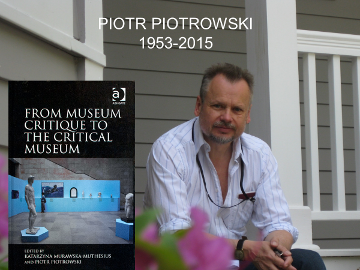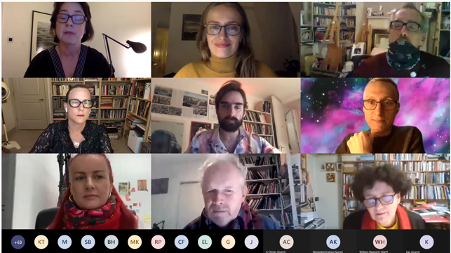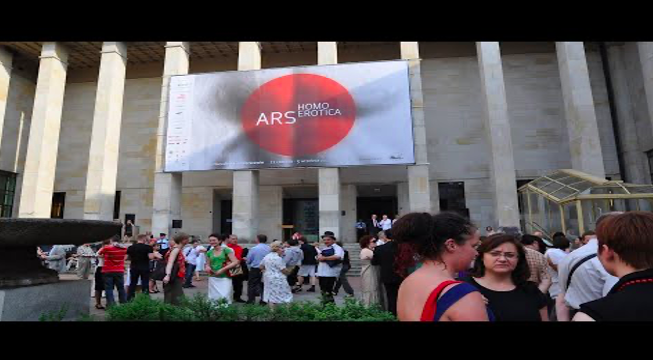
On the evening of 26 November, the virtual common space of Birkbeck’s Centre for Museum Cultures and UCL’s PPV (Perverting the Power Vertical) was filled with almost two hundred virtual guests. They came to discuss the impact of the exhibition which had stirred the audiences and museum corridors in Poland ten years ago, and which reverberates in the museum world until the present. Ars Homo Erotica, curated by Paweł Leszkowicz, and shown at The National Museum in Warsaw from June to August 2010 was the first large scale exhibition which openly championed the equality of the LGBTQ+ community in Poland by demonstrating the endurance of homoerotic themes and aesthetics in art across time and space. It was also a manifesto of the Critical Museum, the new model of the museum institution which, rejecting neutrality claims, takes an active part in the struggle for equality and pluri-versality. The concept of the Critical Museum, which anticipates the current radicalisation of the definition of the museum, was devised by the then Director of the Warsaw Museum, Professor Piotr Piotrowski (1953-2015), the author of ground-breaking books about Eastern European avant-gardes. This event was devoted to his memory.
Ars Homo Erotica: Ten Years Later was organised by Piotrowski’s Deputy at the Warsaw museum at that time, Kasia Murawska-Muthesius, Birkbeck, co-editor, with Piotr Piotrowski, of the book on the Critical Museum, in co-operation with the originators of the Perverting the Power Vertical series of seminars at UCL: Michal Murawski, SEES/ UCL, Masha Mileeva of The Courtauld Institute of Art, and Denis Maksimov.

The event, moderated by Michal Murawski, assembled a panel of distinguished speakers, from Poland, Britain and the US, all of them either directly or indirectly involved in the exhibition. The Curator of Ars Homo Erotica Paweł Leszkowicz presented the political agenda of the exhibition and its scenario, made of sections focused on homoerotic themes in art, such as ‘Male Nude’, ‘Saint Sebastian’, ‘Lesbian Imaginarium’, ‘Transgender’, and history, from ‘Homoerotic Classicism’ to ‘The Time of Struggle’, focused on art and LGBT activism in East Central Europe. He also claimed that the operation of queering museum collections, initiated in Warsaw, should be continued in all museums, all the way up to Vatican. Maura Reilly, who listed the exhibition among the most significant shows on gender issues in her award-winning book Curatorial Activism: Towards an Ethics of Curating, contextualised Ars Homo Erotica’s impact in Poland within the politics of the feminist and LGBTQ+ movement. The philosopher and civic activist Tomek Kitliński, and the Scottish painter Angus Reid, whose exhibition of gay male nudes Parallel Lives is now on show at Summerhall, Edinburgh, talked about the current protests in Poland, focusing on the political dimension of gender and queer in Eastern Europe. Anastasiia Fedorova presented her Instagram exhibition of the Russian queer revolution. Finally, Kasia Perlak, a Polish artist active in London, showed extracts from her poignant films which rework the most heteronormative forms of culture, folk songs and the wedding ceremony, as sites of queer resistance, amidst the escalation of homophobic violence in Poland. Lively discussions followed. Among the topics raised were the political dimension of queer, the issue of intersectionality brought up by Erica Lehrer, the concept of curating love, as well as the idea of nomadic shows in provinces untangling and endorsing homoerotic love, proposed by Natalia Romik. The informal conversation with Sarah Wilson ran long after the event was officially closed. A recording of the event, by William Haggerty, is accessible at Ars Homo Erotica – Ten Years Later.

The event was organised jointly by Birkbeck’s Centre for Museum Cultures; PPV (Perverting the Power Vertical), a research and art platforms based at the FRINGE Centre (UCL SSEES/Institute for Advanced Studies) and The Courtauld Institute of Art.